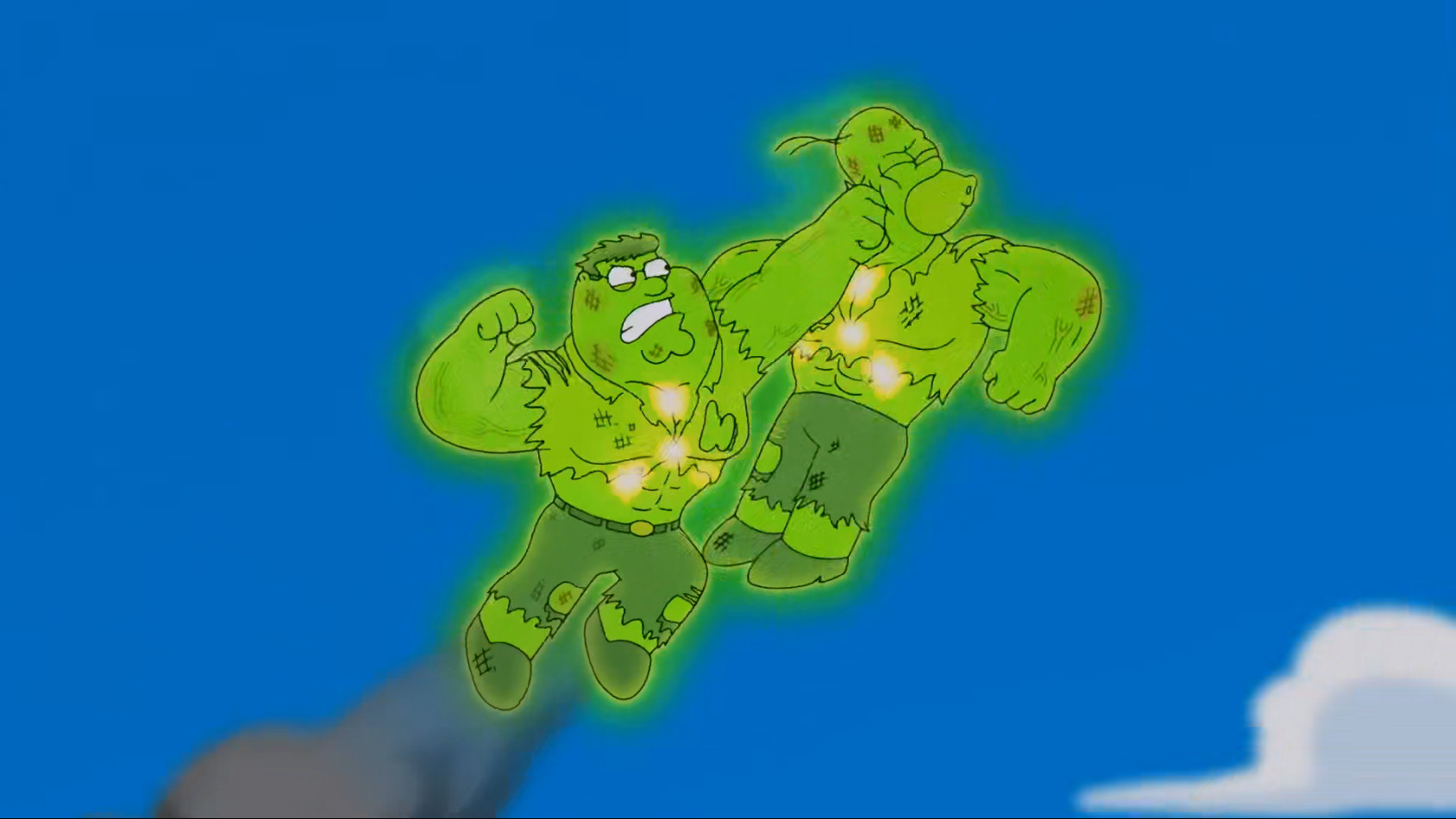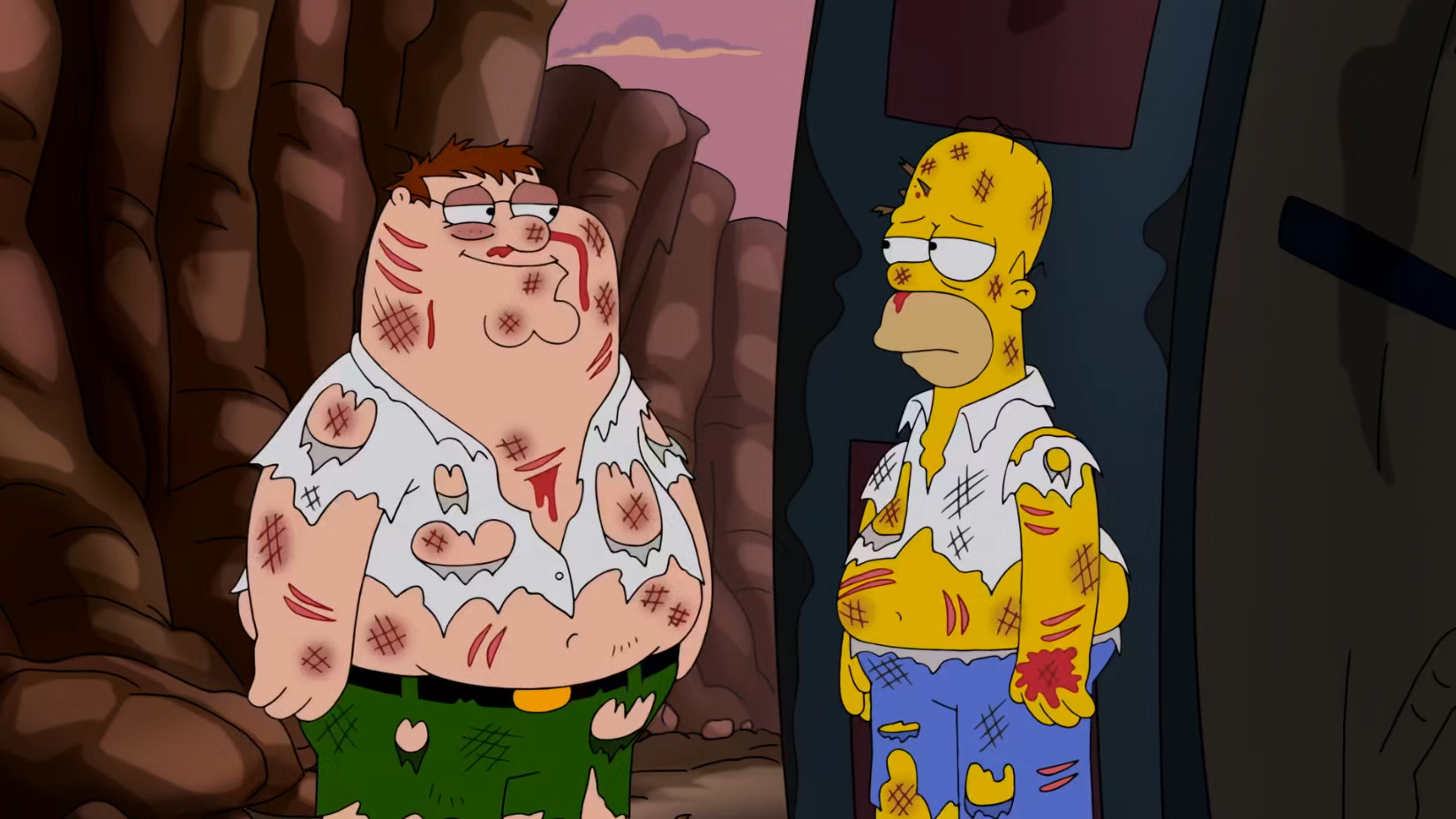When the worlds of Family Guy and The Simpsons collided in “The Simpsons Guy,” it was an event met with both anticipation and a healthy dose of skepticism. Could these two animated titans, both cultural cornerstones in their own right, truly mesh? For many, including myself with a past aversion to Family Guy, the crossover was a curious experiment. This episode promised a unique blend of Springfield and Quahog, and we delve into whether it delivered a comedic goldmine or simply fell flat, examining how “The Simpsons Guy” navigated the styles of these iconic shows. Initially, Family Guy wasn’t exactly my cup of tea, but revisiting this crossover offered a chance to re-evaluate both the episode and my own perceptions of the show.
 Peter Griffin in his newspaper cartoonist role, showcasing his crudely drawn and offensive cartoons.
Peter Griffin in his newspaper cartoonist role, showcasing his crudely drawn and offensive cartoons.
My younger self harbored a distinct dislike for Family Guy. Following its initial cancellation and subsequent resurgence through DVD sales and Adult Swim reruns, the show’s revival in 2005 coincided with my high school years. During this period, Family Guy DVDs were ubiquitous, and as someone known for appreciating cartoons, the assumption was I must be a Family Guy enthusiast. Far from it. Having sampled a few episodes, the humor didn’t resonate, and the show’s overwhelming popularity, coupled with those assumptions, only amplified my negative feelings. The reliance on pop culture cutaway gags, often feeling random and lacking satirical depth, was a major sticking point. A prime example remains the Back to the Future parody, where Doc Brown’s future trip is motivated by preventing Marty’s daughter from marrying a Black man – a joke solely based on inexplicable racism, devoid of context within the movie or episode. While Family Guy shared South Park‘s penchant for shock humor, it often felt like crassness for its own sake, simply aiming for racist, sexist, and homophobic jokes without deeper purpose. This initial distaste solidified throughout high school. Later, in college, those strong feelings softened, and while I might have voiced my dislike for Family Guy and Seth MacFarlane in the past, my stance has become more neutral. Simply put, his brand of comedy doesn’t particularly amuse me.
 The Griffin family encountering Springfield and the iconic Simpsons house.
The Griffin family encountering Springfield and the iconic Simpsons house.
Since Family Guy‘s return, Seth MacFarlane’s comedic influence has expanded significantly. He’s launched more animated series, ventured into live-action films, and created The Orville, a live-action series often seen as a high-budget Star Trek homage. While MacFarlane voices numerous Family Guy characters, suggesting his continued involvement, Matt Groening’s role with The Simpsons seems less hands-on. Regardless, Family Guy, now in its nineteenth season, has cemented its place as a television institution, mirroring its inspiration, The Simpsons. Disney’s acquisition of FOX positioned both shows as equally valuable assets, both being animated comedy juggernauts with extensive episode catalogs, though many long-time fans perceive a decline in quality over time. The point at which Family Guy‘s quality supposedly dipped is debated, much like The Simpsons, with some favoring the initial seasons while others found merit in the revival before a perceived downturn. By 2014, both Family Guy and The Simpsons had become cultural touchstones, with older fans often losing interest in their newer episodes. This context made the idea of a crossover, “The Simpsons Guy”, seem almost inevitable.
 Stewie Griffin imitating Bart Simpson's style and attitude, seeking his approval.
Stewie Griffin imitating Bart Simpson's style and attitude, seeking his approval.
Hearing about “The Simpsons Guy” came after my own departure from regularly watching The Simpsons. The prospect of a crossover with “the enemy” didn’t evoke strong feelings – what more could The Simpsons lose at that point? Yet, morbid curiosity was absent; the Homer and Peter car wash clip alone was enough to deter me. Many inquired if I’d review “The Simpsons Guy,” but as it was a Family Guy episode (unlike the Futurama crossover, which was a Simpsons episode and thus reviewed), I initially declined. However, in the spirit of exploration, I decided to watch the crossover, aiming to understand its execution and reassess my views on contemporary Family Guy.
The initial minutes of “The Simpsons Guy” establish the Griffins’ journey to Springfield. Peter’s brief stint as a newspaper cartoonist and the ensuing controversy over his offensive cartoons offer a snapshot of modern Family Guy humor. His crudely drawn comics, featuring bestiality jokes and spousal abuse punchlines, are deliberately inflammatory. While their on-the-nose offensiveness elicited a surprised laugh, it highlighted the series’ overall tone – a pervasive meanness seemingly detached from specific commentary, existing as crassness for its own sake. Within this episode, it’s somewhat palatable, but the sustainability of this approach over nearly two decades seems questionable. An angry mob forces the Griffins to flee, their car is stolen at a gas station, and serendipitously, they find themselves in Springfield, USA – the quintessential cartoon town.
 Homer Simpson and Peter Griffin engaging in a car washing activity in skimpy outfits.
Homer Simpson and Peter Griffin engaging in a car washing activity in skimpy outfits.
The Griffins’ arrival quickly leads to a meeting with Homer Simpson, and subsequently, the entire Simpson family. While Homer and Peter embark on a quest to recover the stolen car, the other family members pair off. Stewie becomes fixated on Bart, adopting his style and seeking his approval, a strangely endearing dynamic (“Y’know, I’m only wearing this diaper as a dare. It’s not like an every day thing…”). The prank call scene to Moe, particularly Stewie’s shocking line, was a point of discussion upon airing. Juxtaposed with Bart’s innocent prank, it effectively illustrates the comedic contrast between the two shows. Lisa, in her subplot with Meg, attempts to boost Meg’s self-esteem, only to become resentful when Meg excels at saxophone playing. This moment feels distinctly like modern Lisa, (“It would be a shame to waste such great butcher’s arms on a musical instrument.”). However, Lisa later redeems herself, gifting the saxophone to Meg as a parting gift. Meg’s self-deprecation is met with Lisa’s sincere, “Shut up, Meg,” another surprisingly genuine interaction that blends the shows’ styles. The Simpsons’ shock at the Griffins’ bluer humor is also highlighted, like Meg’s casual mention of cat-beating, prompting Lisa to quickly shut the door on Snowball II. Chris and Brian’s subplot involves walking Santa’s Little Helper, with Brian’s annoyance at the Simpson dog’s behavior. Their chase through Springfield serves as a convenient tour of iconic locations and characters – Patty & Selma at the DMV, Dr. Nick at the hospital, and Krusty at Krusty Burger. This segment cleverly incorporates Springfield’s landmarks and residents. Marge and Lois’ outing is relegated to off-screen, humorously acknowledging both series’ limited focus on female characters.
Homer and Peter’s car-finding mission is the episode’s weakest link. Their attempt to “think like a car,” involving gasoline consumption and rectal administration, followed by a car wash in skimpy outfits to Def Leppard’s “Pour Some Sugar on Me,” is intentionally gross and drawn out to the point of losing comedic value. The episode improves with the car’s return, stolen by Hans Moleman. Peter, in gratitude, introduces Homer to Pawtucket Patriot Ale at Moe’s. Homer’s outrage at discovering it’s just Duff in a different label initiates the central conflict. The beer rivalry allegory is overt, yet the dialogue acknowledges this, (“Duff is an icon!” “Yeah, but some folks prefer Pawtucket Pat. Don’t get me wrong, I used to love Duff when I was younger, but I haven’t even had it in like, thirteen years.”). This leads to a court case where Peter is sued for grand theft. The courtroom scene is populated with characters from both shows, and the Blue-Haired Lawyer narrates the similarities between Springfield and Quahog, ranging from the obvious to the tenuous. Fred Flintstone presides as judge, deeming both parties unoriginal and ruling in favor of Duff, resulting in job losses at Pawtucket Brewery.
 The climactic fight scene between Homer Simpson and Peter Griffin, extending across Springfield.
The climactic fight scene between Homer Simpson and Peter Griffin, extending across Springfield.
As the Griffins prepare to leave, Peter’s outburst at Homer for his job loss ignites a seven-minute brawl. This extended fight sequence, reminiscent of Peter’s battles with the Giant Chicken, spans across Springfield, culminating in a fall into the power plant reactor, a trip to Kang and Kodos’ spaceship, and a plunge into Springfield Gorge. The joke seemingly lies in the fight’s excessive length, but it mostly induces boredom. The intense violence, with Homer and Peter seemingly trying to kill each other, feels misplaced, particularly seeing Homer in a murderous light. While Family Guy rules apply, it’s still jarring to witness. Ultimately, they reconcile (“I’m sorry we fought. I just wanted to make you laugh and cry. You see, I’m a Family Guy.” “I understand. I’m a The Simpsons.”). Back in Quahog, Lois provides a logical, if flimsy, resolution regarding the lawsuit’s enforceability (“We lost, but how are they gonna enforce it? What, are they gonna come here? I think we know that’s never gonna happen!”).
 A scene depicting Stewie Griffin and Brian Griffin from Family Guy, highlighting their dynamic.
A scene depicting Stewie Griffin and Brian Griffin from Family Guy, highlighting their dynamic.
“The Simpsons Guy” undeniably surpasses “Simpsorama” as a crossover. While “Simpsorama” offered little beyond Homer and Bender’s drinking camaraderie and superficial cameos, “The Simpsons Guy” actively pairs characters and explores their interactions. It feels like the best possible Simpsons/Family Guy crossover, at least within the realm of modern Simpsons. It’s undeniably a Family Guy episode featuring Simpsons characters. Visually, Simpsons characters within Family Guy‘s flat staging is noticeable, though character models are accurate. Writing-wise, while Simpsons-centric scenes are limited, they capture the tone of season 26 Simpsons, perhaps even slightly elevated. The episode’s strength lies in character interplay and the meta-commentary on Family Guy being a “rip-off,” well-plotted and entertaining overall. Even Family Guy-specific moments, like the Stewie-Brian dynamic (“He’s like something out of Mark Twain!” “Whose real name was Samuel Clemens!” “…how does that further this conversation?”), are enjoyable. Meta-jokes, such as Peter referencing cutaway gags to a confused Homer, and Peter’s fourth-wall break about episode length, also land effectively.
 A group shot of various characters from both The Simpsons and Family Guy interacting.
A group shot of various characters from both The Simpsons and Family Guy interacting.
Despite elements like the prolonged car wash and the excessive fight, “The Simpsons Guy” was surprisingly enjoyable. While leaning more towards Family Guy‘s style, given the contemporary quality of The Simpsons, this isn’t necessarily a detriment. Frankly, I was taken aback by how much I liked it. For Family Guy enthusiasts, former fans, or those with evolving opinions, I’m interested in hearing your perspectives on the show’s trajectory – its peaks and valleys, its evolution, and its current state. The show’s increased meta and self-referential nature is evident, but whether this is positive or negative is up for debate. Is there a counterpart to Me Blog Write Good, dedicated to chronicling every Family Guy episode, lamenting the decline of newer seasons? That would indeed be a sight to behold.

